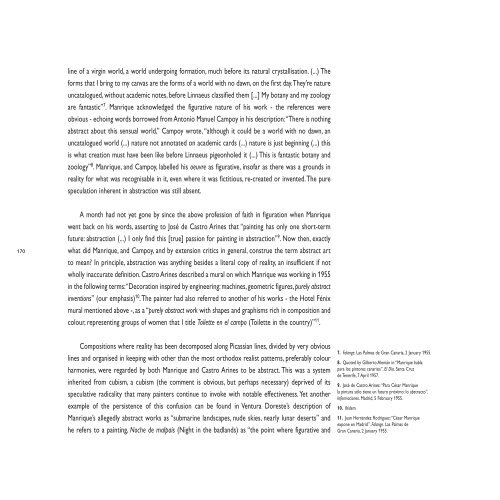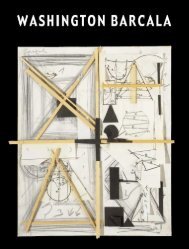VERSIÓN INGLESA ENGLISH VERSION - Fundación César Manrique
VERSIÓN INGLESA ENGLISH VERSION - Fundación César Manrique
VERSIÓN INGLESA ENGLISH VERSION - Fundación César Manrique
Create successful ePaper yourself
Turn your PDF publications into a flip-book with our unique Google optimized e-Paper software.
170<br />
line of a virgin world, a world undergoing formation, much before its natural crystallisation. (...) The<br />
forms that I bring to my canvas are the forms of a world with no dawn, on the first day. They’re nature<br />
uncatalogued, without academic notes, before Linnaeus classified them [...] My botany and my zoology<br />
are fantastic” 7 . <strong>Manrique</strong> acknowledged the figurative nature of his work - the references were<br />
obvious - echoing words borrowed from Antonio Manuel Campoy in his description: “There is nothing<br />
abstract about this sensual world,” Campoy wrote, “although it could be a world with no dawn, an<br />
uncatalogued world (...) nature not annotated on academic cards (...) nature is just beginning (...) this<br />
is what creation must have been like before Linnaeus pigeonholed it (...) This is fantastic botany and<br />
zoology” 8 . <strong>Manrique</strong>, and Campoy, labelled his oeuvre as figurative, insofar as there was a grounds in<br />
reality for what was recognisable in it, even where it was fictitious, re-created or invented. The pure<br />
speculation inherent in abstraction was still absent.<br />
A month had not yet gone by since the above profession of faith in figuration when <strong>Manrique</strong><br />
went back on his words, asserting to José de Castro Arines that “painting has only one short-term<br />
future: abstraction (...) I only find this [true] passion for painting in abstraction” 9 . Now then, exactly<br />
what did <strong>Manrique</strong>, and Campoy, and by extension critics in general, construe the term abstract art<br />
to mean? In principle, abstraction was anything besides a literal copy of reality, an insufficient if not<br />
wholly inaccurate definition. Castro Arines described a mural on which <strong>Manrique</strong> was working in 1955<br />
in the following terms: “Decoration inspired by engineering: machines, geometric figures, purely abstract<br />
inventions” (our emphasis) 10 . The painter had also referred to another of his works - the Hotel Fénix<br />
mural mentioned above -, as a “purely abstract work with shapes and graphisms rich in composition and<br />
colour, representing groups of women that I title Toilette en el campo (Toilette in the country)” 11 .<br />
Compositions where reality has been decomposed along Picassian lines, divided by very obvious<br />
lines and organised in keeping with other than the most orthodox realist patterns, preferably colour<br />
harmonies, were regarded by both <strong>Manrique</strong> and Castro Arines to be abstract. This was a system<br />
inherited from cubism, a cubism (the comment is obvious, but perhaps necessary) deprived of its<br />
speculative radicality that many painters continue to invoke with notable effectiveness. Yet another<br />
example of the persistence of this confusion can be found in Ventura Doreste’s description of<br />
<strong>Manrique</strong>’s allegedly abstract works as “submarine landscapes, nude skies, nearly lunar deserts” and<br />
he refers to a painting, Noche de malpaís (Night in the badlands) as “the point where figurative and<br />
7. Falange. Las Palmas de Gran Canaria, 2 January 1955.<br />
8. Quoted by Gilberto Alemán in “<strong>Manrique</strong> habla<br />
para los pintores canarios”. El Día. Santa Cruz<br />
de Tenerife, 7 April 1957.<br />
9. José de Castro Arines: “Para <strong>César</strong> <strong>Manrique</strong><br />
la pintura sólo tiene un futuro próximo: lo abstracto”.<br />
Informaciones. Madrid, 5 February 1955.<br />
10. Ibídem.<br />
11. Juan Hernández Rodríguez: “<strong>César</strong> <strong>Manrique</strong><br />
expone en Madrid”. Falange. Las Palmas de<br />
Gran Canaria, 2 January 1955.
















![Becas y premios de la Fundación César Manrique [1997-2006]](https://img.yumpu.com/20766851/1/184x260/becas-y-premios-de-la-fundacion-cesar-manrique-1997-2006.jpg?quality=85)
